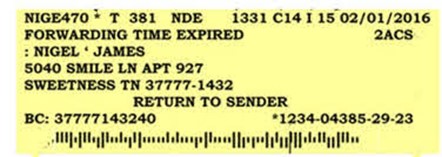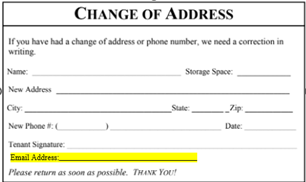Customer Service, Management, Operations, Self-Storage
Handling a Tenant Change of Address
You Must Handle a Tenant’s Change of Address Correctly
In self-storage, in order to handle a tenant change of address correctly and modify the management software or the rental lease agreement, you must have a written change of address signed and dated by the tenant. It is essential to have this document; you cannot accept a phone call where the tenant or someone claiming to be their representative states they’ve changed their address. A written letter from the tenant or an email from the address listed in the tenant’s lease agreement is acceptable.
Make sure to write or stamp the date on any documentation you receive. If you receive an email, it will be automatically dated. However, if you get a letter in the mail, stamp the envelope with the date or write the date and your initials on it, indicating when you received it.
This practice is crucial. For example, I have encountered situations where I was reviewing lien folders and discovered that someone was about to go to auction with five or six changes of address—none of which were dated. As a result, we failed to send notifications to all those addresses. Reviewing the file and notes, I found no record of when these changes occurred, forcing me to start the process from scratch. Therefore, keeping accurate and dated records is extremely important.
These Don’t Count!
None of the following qualifies as a written notice of a change of address: the yellow USPS return mail stickers, checks bearing alternate addresses, or return addresses. Many managers mistakenly think that if a document comes from a different location, they should update the customer’s address in the system. This approach is incorrect. It’s essential to keep records of alternate addresses.
For instance, if a primary contact has no secondary address listed, you could enter an alternate address in the designated area. However, you should not change the primary address until you receive confirmation directly from the customer.
Interestingly, some managers might say, “I received one of those yellow change of address stickers.” It’s important to ask, “What does it say?” because that’s the key piece of information. When you receive one of these stickers, you should document the forwarding address indicated on the yellow sticker in the computer notes without changing the address.

For example, the yellow sticker in the upper right corner mentions Jane Nigel at Sweet Lane, Sweetness, Tennessee. This seems suspicious; it might be a bogus address. Other stickers may state, “Unable to forward – no forwarding order on file.” This could mean the forwarding order has expired. The timeframe could have lapsed. Or, there is simply no alternate address on record for this person, who may have vanished.
Remember to keep these items; do not throw them away. They can provide meaningful context if someone asks why a document was not sent to a different address or why it was sent to the new address mentioned on the yellow sticker. In such a case, you can explain that we received that information but will continue to send correspondence to the original address.
Changing the Tenant’s Address
Ultimately, do not complete a tenant change of address until you have a signed document from the customer and have verified the signature. Sometimes, you receive a request for a change of address, and you might think, “This doesn’t look like the usual signature.” It could be an ex-girlfriend or someone else trying to change the address to cause trouble. I’ve experienced this a few times over the years, and it can be surprising.
So, remember never to accept an official change of address request over the phone. Of course, you can take down this information. But then you must inform the caller you need them to email or send you a signed change of address form for it to be official. You can enter the information for now but must receive proper documentation.
Even if you know the caller well, following the correct procedures is essential. This is crucial because if someone else takes over the account, they may not recognize the caller.

If you receive a call regarding a tenant change of address, make a notation in your management software. Then, promptly mail or email the required change of address form.
Once you receive the new address information, attaching this copy to the lease agreement is essential. This step is critical. If a tenant wishes to change their email address for future notifications, you should use a change of address form. Alternatively, if you have a specific form for updating email addresses, you can use that as well. Be sure to update the address in the management software and note it in the tenant ledger.
Including both the physical address and the email address is essential these days. From my personal experience, I’ve moved several times lately, yet my email address hasn’t changed in years. It’s a reliable way for people to reach me, so don’t rely solely on physical addresses.


